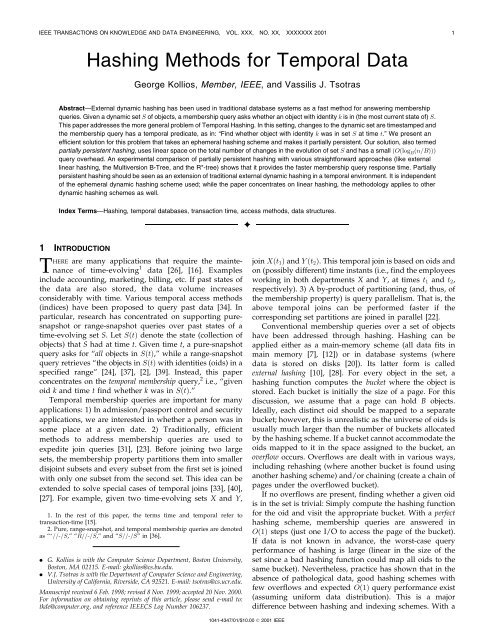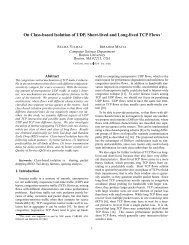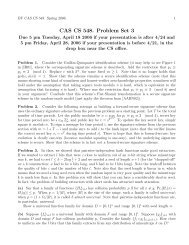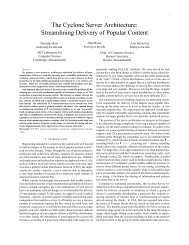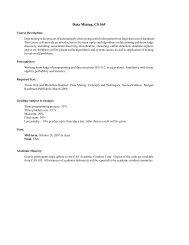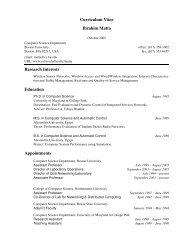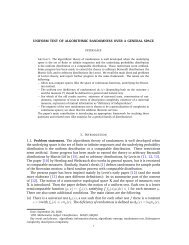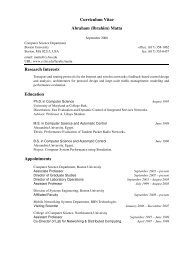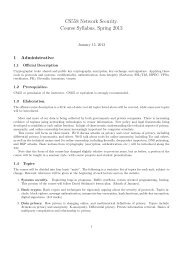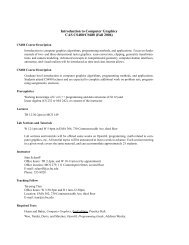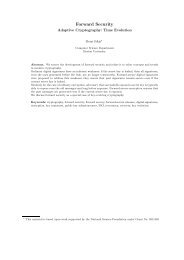Hashing Methods for Temporal Data - Computer Science - Boston ...
Hashing Methods for Temporal Data - Computer Science - Boston ...
Hashing Methods for Temporal Data - Computer Science - Boston ...
Create successful ePaper yourself
Turn your PDF publications into a flip-book with our unique Google optimized e-Paper software.
IEEE TRANSACTIONS ON KNOWLEDGE AND DATA ENGINEERING, VOL. XXX, NO. XX, XXXXXXX 2001 1<br />
<strong>Hashing</strong> <strong>Methods</strong> <strong>for</strong> <strong>Temporal</strong> <strong>Data</strong><br />
George Kollios, Member, IEEE, and Vassilis J. Tsotras<br />
AbstractÐExternal dynamic hashing has been used in traditional database systems as a fast method <strong>for</strong> answering membership<br />
queries. Given a dynamic set S of objects, a membership query asks whether an object with identity k is in the most current state of) S.<br />
This paper addresses the more general problem of <strong>Temporal</strong> <strong>Hashing</strong>. In this setting, changes to the dynamic set are timestamped and<br />
the membership query has a temporal predicate, as in: ªFind whether object with identity k was in set S at time t.º We present an<br />
efficient solution <strong>for</strong> this problem that takes an ephemeral hashing scheme and makes it partially persistent. Our solution, also termed<br />
partially persistent hashing, uses linear space on the total number of changes in the evolution of set S and has a small …O…log B …n=B†††<br />
query overhead. An experimental comparison of partially persistent hashing with various straight<strong>for</strong>ward approaches like external<br />
linear hashing, the Multiversion B-Tree, and the R*-tree) shows that it provides the faster membership query response time. Partially<br />
persistent hashing should be seen as an extension of traditional external dynamic hashing in a temporal environment. It is independent<br />
of the ephemeral dynamic hashing scheme used; while the paper concentrates on linear hashing, the methodology applies to other<br />
dynamic hashing schemes as well.<br />
Index TermsÐ<strong>Hashing</strong>, temporal databases, transaction time, access methods, data structures.<br />
æ<br />
1 INTRODUCTION<br />
THERE are many applications that require the maintenance<br />
of time-evolving 1 data [26],[16]. Examples<br />
include accounting,marketing,billing,etc. If past states of<br />
the data are also stored,the data volume increases<br />
considerably with time. Various temporal access methods<br />
indices) have been proposed to query past data [34]. In<br />
particular,research has concentrated on supporting puresnapshot<br />
or range-snapshot queries over past states of a<br />
time-evolving set S. Let S…t† denote the state collection of<br />
objects) that S had at time t. Given time t,a pure-snapshot<br />
query asks <strong>for</strong> ªall objects in S…t†,º while a range-snapshot<br />
query retrieves ªthe objects in S…t† with identities oids) in a<br />
specified rangeº [24],[37],[2],[39]. Instead,this paper<br />
concentrates on the temporal membership query, 2 i.e.,ªgiven<br />
oid k and time t find whether k was in S…t†.º<br />
<strong>Temporal</strong> membership queries are important <strong>for</strong> many<br />
applications: 1) In admission/passport control and security<br />
applications,we are interested in whether a person was in<br />
some place at a given date. 2) Traditionally,efficient<br />
methods to address membership queries are used to<br />
expedite join queries [31],[23]. Be<strong>for</strong>e joining two large<br />
sets,the membership property partitions them into smaller<br />
disjoint subsets and every subset from the first set is joined<br />
with only one subset from the second set. This idea can be<br />
extended to solve special cases of temporal joins [33],[40],<br />
[27]. For example,given two time-evolving sets X and Y,<br />
1. In the rest of this paper,the terms time and temporal refer to<br />
transaction-time [15].<br />
2. Pure,range-snapshot,and temporal membership queries are denoted<br />
as ª ==-=S, ºªR==-=S, ºandªS==-=Sº in [36].<br />
. G. Kollios is with the <strong>Computer</strong> <strong>Science</strong> Department,<strong>Boston</strong> University,<br />
<strong>Boston</strong>,MA 02115. E-mail: gkollios@cs.bu.edu.<br />
. V.J. Tsotras is with the Department of <strong>Computer</strong> <strong>Science</strong> and Engineering,<br />
University of Cali<strong>for</strong>nia,Riverside,CA 92521. E-mail: tsotras@cs.ucr.edu.<br />
Manuscript received 6 Feb. 1998; revised 8 Nov. 1999; accepted 20 Nov. 2000.<br />
For in<strong>for</strong>mation on obtaining reprints of this article,please send e-mail to:<br />
tkde@computer.org,and reference IEEECS Log Number 106237.<br />
join X…t 1 † and Y …t 2 †. This temporal join is based on oids and<br />
on possibly different) time instants i.e.,find the employees<br />
working in both departments X and Y,at times t 1 and t 2 ,<br />
respectively). 3) A by-product of partitioning and,thus,of<br />
the membership property) is query parallelism. That is,the<br />
above temporal joins can be per<strong>for</strong>med faster if the<br />
corresponding set partitions are joined in parallel [22].<br />
Conventional membership queries over a set of objects<br />
have been addressed through hashing. <strong>Hashing</strong> can be<br />
applied either as a main-memory scheme all data fits in<br />
main memory [7],[12]) or in database systems where<br />
data is stored on disks [20]). Its latter <strong>for</strong>m is called<br />
external hashing [10],[28]. For every object in the set,a<br />
hashing function computes the bucket where the object is<br />
stored. Each bucket is initially the size of a page. For this<br />
discussion,we assume that a page can hold B objects.<br />
Ideally,each distinct oid should be mapped to a separate<br />
bucket; however,this is unrealistic as the universe of oids is<br />
usually much larger than the number of buckets allocated<br />
by the hashing scheme. If a bucket cannot accommodate the<br />
oids mapped to it in the space assigned to the bucket,an<br />
overflow occurs. Overflows are dealt with in various ways,<br />
including rehashing where another bucket is found using<br />
another hashing scheme) and/or chaining create a chain of<br />
pages under the overflowed bucket).<br />
If no overflows are present,finding whether a given oid<br />
is in the set is trivial: Simply compute the hashing function<br />
<strong>for</strong> the oid and visit the appropriate bucket. With a perfect<br />
hashing scheme,membership queries are answered in<br />
O…1† steps just one I/O to access the page of the bucket).<br />
If data is not known in advance,the worst-case query<br />
per<strong>for</strong>mance of hashing is large linear in the size of the<br />
set since a bad hashing function could map all oids to the<br />
same bucket). Nevertheless,practice has shown that in the<br />
absence of pathological data,good hashing schemes with<br />
few overflows and expected O…1† query per<strong>for</strong>mance exist<br />
assuming uni<strong>for</strong>m data distribution). This is a major<br />
difference between hashing and indexing schemes. With a<br />
1041-4347/01/$10.00 ß 2001 IEEE
2 IEEE TRANSACTIONS ON KNOWLEDGE AND DATA ENGINEERING, VOL. XXX, NO. XX, XXXXXXX 2001<br />
balanced index like a B+ tree [5]),answering a membership<br />
query takes logarithmic time on the set size. For many<br />
applications <strong>for</strong> example,in joins [31],[23]),a hashing<br />
scheme with expected constant query per<strong>for</strong>mance one or<br />
two I/Os) is preferable to the logarithmic worst case<br />
per<strong>for</strong>mance four or more I/Os if the set is large) of a<br />
balanced index.<br />
Static hashing refers to schemes that use a predefined<br />
collection of buckets. This is inefficient if the set of objects is<br />
allowed to change by adding or deleting objects from it).<br />
Instead,a dynamic hashing scheme has the property of<br />
allocating space proportional to the set size. Various<br />
external dynamic hashing schemes [19],[11],[9] have been<br />
proposed,among which linear hashing [20] appears to be the<br />
most commonly used.<br />
Even if the set evolves,traditional dynamic hashing is<br />
ephemeral,i.e.,it answers membership queries on the most<br />
current state of set S. The problem addressed in this paper is<br />
more general as it involves membership queries <strong>for</strong> any<br />
state that set S exhibited.<br />
Assume that <strong>for</strong> every time t when S…t† changes by<br />
adding/deleting objects) we could have a good ephemeral<br />
dynamic hashing scheme h…t† that maps efficiently with<br />
few overflows) the oids of S…t† into a collection of buckets<br />
b…t†. One straight<strong>for</strong>ward solution to the temporal hashing<br />
problem would be to separately store each collection of<br />
buckets b…t† <strong>for</strong> each t. Answering a temporal membership<br />
query <strong>for</strong> oid k and time t requires: 1) identifying h…t† the<br />
hashing function used at t) and 2) applying h…t† on k and<br />
accessing the appropriate bucket of b…t†. This would<br />
provide an excellent query per<strong>for</strong>mance as it uses a<br />
separate hashing scheme <strong>for</strong> each t),but the space<br />
requirements are prohibitively large. If n denotes the<br />
number of changes in S's evolution,storing each b…t† on<br />
the disk could easily create O……n=B† 2 † space.<br />
Instead,we propose a solution that uses space linear in n<br />
but still has good query per<strong>for</strong>mance. We call our solution<br />
partially persistent hashing as it reduces the original problem<br />
into a collection of partially persistent 3 subproblems. We<br />
apply two approaches <strong>for</strong> solving these subproblems. The<br />
first approach "sees" each subproblem as an evolving subset<br />
of set S and is based on the Snapshot Index [37]. The second<br />
approach ªseesº each subproblem as an evolving sublist. In<br />
both cases,the partially persistent hashing scheme<br />
ªobservesº and stores the evolution of the ephemeral<br />
hashing h…t†. While the paper concentrates on linear<br />
hashing,the partially persistence methodology applies to<br />
other dynamic hashing schemes as well <strong>for</strong> example,<br />
extendible hashing [11]).<br />
We compare partially persistent hashing with three other<br />
approaches. The first approach uses a traditional dynamic<br />
hashing scheme to map all oids ever created during the<br />
evolution of S. However,this scheme does not distinguish<br />
among subsequent occurrences of the same oid k created by<br />
adding and deleting k many times. Because all such<br />
occurrences of oid k will be hashed on the same bucket,<br />
bucket sizes will increase and will eventually deteriorate<br />
per<strong>for</strong>mance note that bucket reorganizations will not<br />
solve the problem; this was also observed in [1]). The<br />
second approach assumes that a B+ tree is used to index<br />
each S…t† and makes this B+ tree partially persistent [2],<br />
[39],[24]. The third approach sees each oid-interval<br />
combination as a multidimensional object and uses an<br />
R*-tree [14],[3] <strong>for</strong> storing it. Our experiments show that<br />
the partially persistent hashing outper<strong>for</strong>ms the other<br />
three competitors in membership query per<strong>for</strong>mance<br />
while having a minimal space overhead.<br />
The partially persistent B+ tree [2],[39],[24] is technically<br />
the more interesting among the competitor approaches.<br />
Conceptually,many versions of an ephemeral B+ tree are<br />
embedded into a graph-like structure. This graph has many<br />
root nodes,each root providing access to subsequent<br />
versions of the ephemeral B+ tree,organized by time.<br />
Searching <strong>for</strong> oid k at time t involves: 1) identifying the root<br />
valid at t and 2) searching <strong>for</strong> k through the nodes of the<br />
B+ tree emanating from this root [2]. Part 1 is bounded by<br />
O…log B …n=B††,while part 2 takes O…log B …m=B†† I/Os,where<br />
m corresponds to the number of objects in S…t†. In practice,<br />
however,the I/Os <strong>for</strong> part 1 can be eliminated if enough<br />
main memory is available. For example,[2] identifies the<br />
appropriate root using the root* structure which is kept in<br />
main memory.<br />
It was an open question whether an efficient temporal<br />
extension existed <strong>for</strong> hashing. The work presented here<br />
answers this question positively. Searching with the<br />
partially persistent hashing scheme has also two parts.<br />
The first part is again bounded by O…log B …n=B†† and<br />
identifies the hashing function and appropriate bucket<br />
valid at time t. The second part takes expected O…1† time<br />
i.e.,it is independent of m). In practice,with a large enough<br />
main memory,the I/Os from the logarithmic overhead can<br />
be eliminated. This work supports our conjecture [18] that<br />
transaction-time problems can be solved by taking an<br />
efficient solution <strong>for</strong> the nontemporal problem and making<br />
it partially persistent. Note that as with ephemeral hashing,<br />
the worst-case query behavior of temporal hashing is linear<br />
…O…n=B††,but this is a rather pathological case.<br />
The rest of the paper is organized as follows: Section 2<br />
presents background and previous work. The description of<br />
partially persistent linear hashing appears in Section 3.<br />
Per<strong>for</strong>mance comparisons are presented in Section 4,while<br />
conclusions and open problems <strong>for</strong> further research appear<br />
in Section 5. Table 3 contains the main notations and<br />
symbols used throughout the paper while the Appendix<br />
discusses the update and space analysis of the evolving-list<br />
approach. Table 4 and Table 5 provide further per<strong>for</strong>mance<br />
comparisons to be discussed later).<br />
2 BACKGROUND AND PREVIOUS WORK<br />
A simple model of temporal evolution follows. Assume that<br />
time is discrete,described by the succession of nonnegative<br />
integers. Consider <strong>for</strong> simplicity an initially empty set S.<br />
When an object is added to S and,until if ever) it is deleted<br />
from S,it is called ªalive.º 4 Each object is represented by a<br />
record that stores its oid and a semiclosed interval,or<br />
lifespan,of the <strong>for</strong>m: [start_time, end_time). An object added<br />
at t has its interval initiated as [t,now),where now is a<br />
3. A structure is called persistent if it can store and access its past states<br />
[8]. It is called partially persistent if the structure evolves by applying<br />
changes to its ªmost currentº state. 4. Clearly, S…t† contains all the alive objects at t.
KOLLIOS AND TSOTRAS: HASHING METHODS FOR TEMPORAL DATA 3<br />
variable representing the always increasing current time. If<br />
this object is later deleted,its end_time is updated to the<br />
object's deletion time. Since an object can be added and<br />
deleted many times,records with the same oid may exist,<br />
but with nonintersecting lifespan intervals.<br />
The per<strong>for</strong>mance of a temporal access method is<br />
characterized by three costs: space,query time,and update<br />
time. Update time is the time needed to update the index<br />
<strong>for</strong> a change that happened on set S. Clearly,an index that<br />
solves the range-snapshot query can also solve the puresnapshot<br />
query. However,as indicated in [35],a method<br />
designed to address primarily the pure-snapshot query<br />
does not order incoming changes according to oid and can<br />
thus enjoy faster update time than a method designed <strong>for</strong><br />
the range-snapshot query. Indeed,the Snapshot Index [37]<br />
solves the pure-snapshot query in O…log B …n=B†‡a=B† I/Os,<br />
using O…n=B† space and only O…1† update time per change<br />
in the expected amortized sense [6] because a hashing<br />
scheme is employed). Here, a corresponds to the number of<br />
alive objects in S…t†. This is the I/O-optimal solution <strong>for</strong> the<br />
pure snapshot query [34].<br />
For the range-snapshot query three efficient methods<br />
exist: the TSB tree [24],the MVBT [2],and the MVAS<br />
structure [39]. Both the MVBT and MVAS solve the rangesnapshot<br />
query in O…log B …n=B†‡a=B† I/Os,using<br />
O…n=B† space and O…log B …m=B†† update per change in<br />
the amortized sense [6]). Here, m denotes the number of<br />
ªaliveº objects when an update takes place and a denotes<br />
the number of objects from S…t† with oids in the query<br />
specified range. This is the I/O-optimal solution <strong>for</strong> the<br />
range-snapshot query. The MVAS structure improves the<br />
merge/split policies of the MVBT,thus resulting in a<br />
smaller constant in the space bound. The TSB tree is another<br />
efficient solution to the range-snapshot query. In practice,it<br />
is more space efficient than the MVBT and MVAS),but it<br />
can guarantee worst-case query per<strong>for</strong>mance only when the<br />
set evolution is described by additions of new objects or<br />
updates on existing objects [30],[34].<br />
To the best of our knowledge,the temporal membership<br />
query is a novel problem [34]. One could,of course,use a<br />
temporal access method designed <strong>for</strong> range-snapshot<br />
queries [24],[2],[39] and limit the query range to a single<br />
oid. There are,however,two disadvantages with this<br />
approach. First,since the range-snapshot access method<br />
orders objects by oid,a logarithmic update …O…log B …m=B†††<br />
is needed. Second,because the range-snapshot method<br />
answers the membership query by traversing a tree path,<br />
the same logarithmic overhead …O…log B …m=B††† appears in<br />
the query time. Nevertheless,in our experiments,we<br />
include a range-snapshot method <strong>for</strong> completeness. Since<br />
we assume that object deletions are frequent,we use the<br />
MVBT instead of the TSB. We use the MVBT instead of the<br />
MVAS since the MVBT disk-based code was readily<br />
available to the authors. As explained in the per<strong>for</strong>mance<br />
analysis section,the MVBT was also compared with a mainmemory-based<br />
simulation of the MVAS,but there was no<br />
drastic per<strong>for</strong>mance difference among the two methods <strong>for</strong><br />
the temporal membership query.<br />
2.1 The Snapshot Index and Linear <strong>Hashing</strong><br />
The Snapshot Index [37] uses three basic structures: A<br />
balanced tree time-tree) that indexes data pages by time,a<br />
pointer structure access-<strong>for</strong>est) among the data pages,and<br />
an ephemeral hashing scheme. The time-tree and the access<strong>for</strong>est<br />
enable fast query response,while the hashing scheme<br />
is used <strong>for</strong> fast update. When an object is added in set S,its<br />
record is stored sequentially in a data page. When an object<br />
is deleted from S,its record is located and its end_time is<br />
updated. The main advantage in the Snapshot Index,is that<br />
it clusters alive objects together. To achieve this,the method<br />
uses the notion of page usefulness; a page is called useful as<br />
long as it contains uB alive records …0
4 IEEE TRANSACTIONS ON KNOWLEDGE AND DATA ENGINEERING, VOL. XXX, NO. XX, XXXXXXX 2001<br />
A split per<strong>for</strong>med whenever a bucket overflow occurs is<br />
an uncontrolled split. Let l denote the LH file's load factor,i.e.,<br />
l ˆjSj=Bjbj,where jSj is the current size cardinality) of<br />
set S and jbj the current number of buckets in the LH file.<br />
The load factor achieved by uncontrolled splits is usually<br />
between 50-70 percent,depending on the page size and<br />
the oid distribution [20]. In practice,a higher storage<br />
utilization is achieved if a split is triggered not by an<br />
overflow,but when the load factor l becomes greater than<br />
some upper threshold g …g 1† [20],[10],[13]. This is called a<br />
controlled split and can typically achieve 95 percent utilization.<br />
Note that the split is now independent of bucket<br />
overflows. Other controlled schemes exist where a split is<br />
delayed until both the threshold condition holds and an<br />
overflow occurs). Deletions in set S will cause the LH file to<br />
shrink. Buckets that have been split can be recombined in<br />
reverse linear order) if the load factor falls below some lower<br />
threshold f…0
KOLLIOS AND TSOTRAS: HASHING METHODS FOR TEMPORAL DATA 5<br />
Fig. 1. Two instants in the evolution of an ephemeral hashing scheme. a) Until time t ˆ 20, no split has occurred and p ˆ 0. b)Att ˆ 21, oid 8 is<br />
mapped to bucket 3 and causes a controlled split. Bucket 0 is rehashed using h 1 and p ˆ 1.<br />
Fig. 2. The detailed evolution <strong>for</strong> set S until time t ˆ 25. The addition of oid 8 in S at t ˆ 21 causes the first split. Moving oid 15 from bucket 0 to<br />
bucket 5 is seen as a deletion and an addition, respectively.<br />
corresponds to the number of changes recorded in bucket<br />
b j 's history at worst n j is O…n†).<br />
In practice,we expect that: 1) s is small compared to n,<br />
i.e.,array H will use few pages and can thus be stored in<br />
main memory. 2) Most of S's history will be recorded on the<br />
first 2 i M buckets <strong>for</strong> some i); then, n j behaves as<br />
O…n=2 i M†† and searching b j 's time-tree is rather fast.<br />
3.1.1 Update and Space Analysis<br />
It suffices to show that the partially persistent linear<br />
hashing scheme uses O…n=B† space. An O…1† amortized
6 IEEE TRANSACTIONS ON KNOWLEDGE AND DATA ENGINEERING, VOL. XXX, NO. XX, XXXXXXX 2001<br />
expected update processing per change can then be derived.<br />
Assume that the corresponding ephemeral linear hashing<br />
scheme LH…t† starts with M initial buckets and uses upper<br />
threshold g. Assume,<strong>for</strong> simplicity,that set S evolves by<br />
only adding oids oid additions create new records and,<br />
hence,more copying; deletions do not create splits).<br />
Clearly,array H satisfies the space bound. Next,we<br />
show that the space used by bucket histories is also<br />
bounded by O…n=B†. Since,<strong>for</strong> partially persistent linear<br />
hashing,each split creates artificial changes the oids<br />
moved to a new bucket are deleted from the previous<br />
bucket and subsequently added to a new bucket as new<br />
records),it must be shown that the number of oid moves<br />
copies) due to splits is still bounded by the number of real<br />
changes n. We will first use two lemmas that upper and<br />
lower bound such oid moves during the first round of<br />
splits.<br />
Lemma 1. For any N in 1 N M,N splits occur after at least<br />
…M ‡ N 1†Bg real object additions happen.<br />
Proof. Just be<strong>for</strong>e the Nth split,we have exactly M ‡ N 1<br />
buckets and,hence,the load is l ˆjSj=B…M ‡ N 1†. By<br />
definition,<strong>for</strong> the next controlled split to occur,we must<br />
have l>g,which implies that l ˆjSj= >…M ‡ N 1†Bg.tu<br />
Lemma 2. For any N in 1 N M,N splits can create at most<br />
…M ‡ N 1†B ‡ 1 oid copies.<br />
Proof. Assume that all buckets are initially empty. Observe<br />
that the number of oid copies made during a single<br />
round is at most equal to the number of real object<br />
additions. This is because,during one round,an oid is<br />
rehashed at most once. The number of real additions<br />
be<strong>for</strong>e a split increases with g lower g triggers a split<br />
earlier,i.e.,with less oids). Hence,the most real<br />
additions occur when g ˆ 1. The Nth controlled split is<br />
then triggered when the load exceeds 1. Since there<br />
are already M ‡ N 1 buckets,this happens at the<br />
……M ‡ N 1†B ‡ 1†th object addition. tu<br />
The basic theorem about space and updating follows:<br />
Theorem 1. Partially Persistent Linear <strong>Hashing</strong> uses space<br />
proportional to the total number of real changes and updating<br />
that is amortized expected O…1† per change.<br />
Proof. As splits occur,linear hashing proceeds in rounds. In<br />
the first round,variable p starts from bucket 0 and,in the<br />
end of the round,it reaches bucket M 1. At that point,<br />
2M buckets are used and all copies remappings) from<br />
oids of the first round have been created. Since M splits<br />
have occurred,Lemma 2 implies that there must have<br />
been at most …2M 1†B ‡ 1 oid moves copies). By<br />
construction,these copies are placed in the last M buckets.<br />
For the next round,variable p will again start from<br />
bucket 0 and will extend to bucket 2M 1. When p<br />
reaches bucket 2M 1,there have been 2M new splits.<br />
These new splits imply that there must have been at most<br />
…4M 1†B ‡ 1 copies created from these additions. The<br />
copied oids from the first round are seen in the second<br />
round as regular oid additions. At most,each such oid<br />
can be copied once more during the second round the<br />
original oids from which these copies were created in the<br />
first round,cannot be copied again in the second round<br />
as they represent deleted records in their corresponding<br />
buckets). Hence,the maximum number of copies after<br />
the second round is ……2M 1†B ‡ 1 ‡…4M 1†B ‡ 1†.<br />
The total number of copies C total created in all rounds<br />
satisfies:<br />
C total ‰f…2M 1†B ‡ 1g‡<br />
f…2M 1†B ‡ 1 ‡…4M 1†B ‡ 1g‡...Š;<br />
where each {} represents copies per round. Using M 1<br />
and B>1,we get:<br />
" #<br />
C total ‰2MB ‡f4MB ‡ 2MBg‡...ŠMB Xi X k<br />
2 j<br />
ˆMB‰2…2 i‡1 1† …i ‡ 1†Š < 2 i‡2 MB:<br />
kˆ0 jˆ0<br />
Lemma 1 implies that,after the first round,we have at<br />
least …2M 1†Bg real oid additions. At the end of the<br />
second round,the total number of oid additions is at<br />
least …4M 1†Bg. However, …2M 1†Bg of these were<br />
inserted and counted <strong>for</strong> the first round. Thus,the<br />
second round introduces at least 2MBg new additions.<br />
Similarly,the third round introduces at least 4MBg new<br />
oid additions,etc. The number of real oid additions<br />
A total ,after all rounds,is lower bounded by:<br />
A total ‰f…2M 1†Bgg‡f2MBgg‡f4MBgg‡...Š<br />
‰MBg ‡ 2MBg ‡ 4MBg ‡ ...Š:<br />
Hence,<br />
A total MBg Xi<br />
kˆ0<br />
…1†<br />
2 k ˆ…2 i‡1 1†MBg 2 i MBg: …2†<br />
From 1) and 2),it can be derived that there exists a<br />
positive constant const such that C total =A total < const.<br />
Since A total is bounded by the total number of changes<br />
n,we have C total ˆ O…n†. For proving that partially<br />
persistent linear hashing has O…1† expected amortized<br />
updating per change,we note that when a real change<br />
occurs it is directed to the appropriate bucket,where<br />
the structures of the Snapshot Index are updated in<br />
O…1† expected time. Rehashings must be carefully<br />
examined. This is because a rehashing of a bucket is<br />
caused by a single real oid addition the one that<br />
created the split),but it results in a ªbunchº of copies<br />
made to a new bucket at worse,the whole current<br />
contents of the rehashed bucket are sent to the new<br />
bucket). However,using the space bound,any sequence<br />
of n real changes can at most create O…n† copies extra<br />
work) or,equivalently,O…1† amortized ef<strong>for</strong>t per real<br />
change.<br />
tu<br />
3.1.2 Optimization Issues<br />
Optimizing the per<strong>for</strong>mance of partially persistent linear<br />
hashing involves the load factor l of the ephemeral<br />
Linear <strong>Hashing</strong> and the usefulness parameter u of the<br />
Snapshot Index. Load l lies between thresholds f and g.<br />
Note that l is an average over time of l…t† ˆj…S…t††j=Bjb…t†j,
KOLLIOS AND TSOTRAS: HASHING METHODS FOR TEMPORAL DATA 7<br />
where jS…t†j and jb…t†j denote the size of the evolving set S<br />
and the number of buckets used at t clearly, b…t† jb total j).<br />
A good ephemeral linear hashing scheme will try to equally<br />
distribute the oids among buckets <strong>for</strong> each t. Hence,on<br />
average,the size in oids) of each bucket b j …t† will satisfy<br />
jb j …t†j j…S…t††j=jb…t†j.<br />
One of the advantages of the Snapshot Index is the ability<br />
to tune its per<strong>for</strong>mance through usefulness parameter u. The<br />
index will distribute the oids of each b j …t† among a number of<br />
useful pages. Since each useful page except the acceptor<br />
page) contains at least uB alive oids,the oids in b j …t† will be<br />
occupying at most jb j …t†j=uB j…S…t††j=uBjb…t†j ˆ l…t†=u<br />
pages. Ideally,we would like the answer to a snapshot query<br />
to be contained in a single page. Then,a good optimization<br />
choice is to maintain l=u < 1. Conceptually,load l<br />
gives a measure of the size of a bucket ªaliveº oids) at each<br />
time. These alive oids are stored in the data pages of the<br />
Snapshot Index. Recall that an artificial copy happens if the<br />
number of alive oids in a data page falls below uB. At that<br />
point,the remaining uB 1 alive oids of this page are<br />
copied to a new page. By keeping l below u we expect that<br />
the alive oids of the split page will be copied in a single<br />
page which minimizes the number of I/Os needed <strong>for</strong><br />
finding them.<br />
On the other hand,the usefulness parameter u affects the<br />
space used by the Snapshot Index and in return the overall<br />
space of the persistent hashing scheme. Higher values of u<br />
imply frequent time splits,i.e.,more page copies and,thus,<br />
more space. Hence,it would be advantageous to keep u low<br />
but this implies an even lower l. In return,lower l would<br />
mean that the buckets of the ephemeral hashing are not<br />
fully utilized. This is because low l causes set S…t† to be<br />
distributed into more buckets,not all of which may be fully<br />
occupied.<br />
At first,this requirement seems contradictory. However,<br />
<strong>for</strong> the purposes of partially persistent linear hashing,<br />
having low l is still acceptable. Recall that the low l applies<br />
to the ephemeral hashing scheme whose history the<br />
partially persistent hashing observes and accumulates.<br />
Even though at single time instants the b j …t†s may not be<br />
fully utilized,over the whole time evolution many object<br />
oids are mapped to the same bucket. What counts <strong>for</strong> the<br />
partially persistent scheme is the total number of changes<br />
accumulated per bucket. Because of bucket reuse,a bucket<br />
will gather many changes creating a large history <strong>for</strong> the<br />
bucket and,thus,justifying its use in the partially persistent<br />
scheme. Our findings regarding optimization will be<br />
verified through the experimentation results that appear<br />
in Section 4.<br />
3.2 The Evolving-List Approach<br />
The elements of bucket b j …t† can also be viewed as an<br />
evolving list lb j …t† of alive oids. Such an observation is<br />
consistent with the way buckets are searched in ephemeral<br />
hashing,i.e.,linearly,as if a bucket's contents belong to a<br />
list. Accessing the bucket state b j …t† is then reduced to<br />
reconstructing lb j …t†. Equivalently,the evolving list of oids<br />
should be made partially persistent.<br />
We note that [39] presents a notion of persistent lists<br />
called the C-lists. A C-list is a list structure made up of a<br />
collection of pages that contain temporal versions of data<br />
records clustered by oid. However,a C-list and a partiallypersistent<br />
list solve different problems: 1) A C-list addresses<br />
the query: ªGiven an oid and a time interval,find all<br />
versions of this oid during this interval.º Instead,a partially<br />
persistent list finds all the oids that its ephemeral list had at<br />
a given time instant. 2) In a C-list,the various temporal<br />
versions of an oid must be clustered together. This implies<br />
that oids are also ordered by key. In contrast,a persistent<br />
list does not require ordering its keys,simply because its<br />
ephemeral list is not ordered. 3) In a C-list,updates and<br />
queries are per<strong>for</strong>med by first using the MVAS structure.<br />
Updating/querying the partially persistent list always<br />
starts from the top of the list and proceeds through a linear<br />
search.<br />
For the evolving-list approach,a list page has now two<br />
areas. The first area is used <strong>for</strong> storing oid records and its<br />
size is B r B r is O…B†). The second area,of size B-B r B-B r is<br />
also O…B†),accommodates an extra structure array NT),<br />
which will be explained shortly. When the first oid k is<br />
added on bucket b j at time t,a record is<br />
appended in the first list page. Additional oid insertions<br />
will create record insertions in this page. When the B r part<br />
of the first page gets full of records,a new page is appended<br />
in the list and so on. If oid k is deleted at t 0 from the bucket,<br />
its record in the list is found by a serial search among the<br />
list pages and its end_time is updated.<br />
Good clustering is achieved if each page in lb j …t† is a<br />
useful page. A page is useful if 1) it is full of records and<br />
contains at least uB r alive records …0 ,where pid is the<br />
address of the first page. When the first page of the list<br />
changes,a new entry is appended in FT j . This array can be<br />
implemented as a multilevel index since entries are added<br />
in increasing time order. Each remaining page of lb j …t† is<br />
found by the second structure,which is an array of size<br />
B-B r ,implemented inside every list page. Let NT…A† be the<br />
array inside page A. This array is maintained <strong>for</strong> as long as<br />
the page is useful. Entries in NT…A† are also of the <strong>for</strong>m<br />
,where pid corresponds to the address of the<br />
next list page after page A.<br />
To answer a temporal membership query <strong>for</strong> oid k at<br />
time t the appropriate bucket b j ,where oid k would have<br />
been mapped by the hashing scheme at t is found. This part<br />
is the same with the evolving-set approach. To reconstruct<br />
bucket b j …t†,the first page in lb j …t† is retrieved by searching t<br />
in array FT j . This search is O…log B …n j =B††. The remaining<br />
pages of lb j …t† are found by locating t in the NT array of<br />
each subsequent list page. Since all pages in the list lb j …t† are<br />
useful,the oids in b j …t† are found in O…jb j …t†j=B† I/Os.<br />
Hence,the space used by the evolving-list approach is<br />
O…n=B† while updating is O…jb t …t†j=B† per update <strong>for</strong><br />
details,see the Appendix).
8 IEEE TRANSACTIONS ON KNOWLEDGE AND DATA ENGINEERING, VOL. XXX, NO. XX, XXXXXXX 2001<br />
There are two differences between the evolving-list and<br />
the evolving-set approaches. First,updating using the<br />
Snapshot Index remains constant,while,in the evolving<br />
list,the whole current list may have to be searched <strong>for</strong><br />
deleting an oid. Second,reconstruction in the evolving-list<br />
starts from the top of the list pages while,in the evolvingset,reconstruction<br />
starts from the last page of the bucket.<br />
This may affect the search <strong>for</strong> a given oid depending<br />
whether it has been placed near the top or near the end of<br />
the bucket.<br />
4 PERFORMANCE ANALYSIS<br />
For the Partially Persistent Linear <strong>Hashing</strong>,we implemented<br />
the set-evolution PPLH-s) and the list-evolution<br />
PPLH-l) approaches,using controlled splits. Both are<br />
compared against Linear <strong>Hashing</strong> in particular, Atemporal<br />
linear hashing,which is discussed below),the MVBT,and<br />
two R*-tree implementations R i which stores intervals<br />
in a 2-dimensional space and R p which stores points in<br />
a 3-dimensional space). The partial persistence methodology<br />
is applicable to other hashing schemes as well. We<br />
implemented Partially Persistent Extendible <strong>Hashing</strong> using<br />
the set-evolution PPEH-s) and uncontrolled splits and<br />
compared it with PPLH-s. Implementation details and the<br />
experimental setup are described in Section 5.1,the data<br />
workloads in Section 5.2,and our findings in Section 5.3.<br />
4.1 Method ImplementationÐExperimental Setup<br />
We set the size of a page to hold 25 object records B ˆ 25).<br />
In addition to the object's oid and lifespan,the record<br />
contains a pointer to the actual object which may have<br />
additional attributes).<br />
We first discuss the Atemporal linear hashing ALH). It<br />
should be clarified that ALH is not the ephemeral linear<br />
hashing whose evolution the partially persistent linear<br />
hashing observes and stores. Rather,it is a conventional<br />
linear hashing scheme that treats time as just another<br />
attribute. This scheme simply maps objects to buckets using<br />
the object oids. Consequently,it ªseesº the different<br />
lifespans of the same oid as copies of the same oid. We<br />
implemented ALH using the scheme originally proposed by<br />
Litwin in [20]. For split functions,we used the hashing by<br />
division functions h i …oid† ˆoid mod 2 i M with M ˆ 10. For<br />
good space utilization,controlled splits were employed.<br />
The lower and upper thresholds namely, f and g) had values<br />
0.7 and 0.9,respectively.<br />
Another approach <strong>for</strong> Atemporal hashing would be a<br />
scheme which uses a combination of oid and the start_time<br />
or end_time attributes. However,this approach would still<br />
have the same problems as ALH <strong>for</strong> temporal membership<br />
queries. For example,hashing on start_time does not help<br />
<strong>for</strong> queries about time instants other than the start_times.<br />
The two Partially Persistent Linear <strong>Hashing</strong> approaches<br />
PPLH-s and PPLH-l) observe an ephemeral linear hashing<br />
LH…t† with controlled splits and load between f ˆ 0:1 and<br />
g ˆ 0:2. Array H is kept in main memory i.e.,no I/O cost is<br />
counted <strong>for</strong> accessing H). In our experiments,the size of H<br />
varied from 5 to 10 KB which can easily fit in today's main<br />
memories). Unless otherwise noted,PPLH-s was implemented<br />
with u ˆ 0:3 other values <strong>for</strong> usefulness parameter u<br />
were also examined). Since the entries in the time-tree<br />
associated with a bucket have half the object record size,<br />
each time-tree page can hold up to 50 entries.<br />
In the PPLH-l implementation, B r holds 20 object<br />
records. Here,the usefulness parameter was set to<br />
u ˆ 0:25. The remaining space in a list page five object<br />
records) is used <strong>for</strong> the page's NT array. Similarly with<br />
time-arrays,NT arrays have entries of half the size,i.e.,each<br />
page can hold 10 NT entries. For the same reason,the pages<br />
of an FT j array can hold up to 50 entries.<br />
The Multiversion B-tree MVBT) implementation uses<br />
buffering during updates; this buffer stores the pages in the<br />
path to the last update LRU buffer replacement policy is<br />
used). Such buffering can be very advantageous since<br />
updates are directed toward the most current B-tree,which<br />
is a small part of the whole MVBT structure. In our<br />
experiments,we set the buffer size to 10 pages. The original<br />
MVBT uses buffering <strong>for</strong> queries,too. For a fair comparison<br />
with the partially persistent methods,during queries we<br />
allow the MVBT to use a buffer that is as large in size as<br />
array H <strong>for</strong> that experiment. Recall that,during querying,<br />
the MVBT uses a root* structure. Even though root* can<br />
increase with time,it is small enough to fit in the above<br />
main-memory buffer. Thus,we do not count I/O accesses<br />
<strong>for</strong> searching root*.<br />
As with the Snapshot Index,a page in the MVBT is<br />
ªaliveº as long as it has at least q alive records. If the<br />
number of alive records falls below q,this page is merged<br />
with a sibling this is called a weak version underflow in [2]).<br />
On the other extreme,if a page already has B records alive<br />
or not) and a new record is added,the page splits called a<br />
page overflow in [2]). Both conditions need special handling.<br />
First,a time-split happens which is like the copying<br />
procedure of the Snapshot Index). All alive records in the<br />
split page are copied to a new page. Then,the resulting new<br />
page should be incorporated in the structure. The MVBT<br />
requires that the number of alive records in the new page<br />
should be between q ‡ e and B-e,where e is a predetermined<br />
constant. Constant e works as a threshold that<br />
guarantees that the new page can be split or merged only<br />
after at least e new changes. Not all values <strong>for</strong> q, e,and B are<br />
possible as they must satisfy some constraints; <strong>for</strong> details<br />
we,refer to [2]. In our implementation,we set q ˆ 5 and<br />
e ˆ 4.<br />
Another choice <strong>for</strong> a range-snapshot method would be<br />
the MVAS [39],whose updating policies lead to smaller<br />
space requirements than the MVBT. In addition,the MVAS<br />
does not use the root* structure. With either method,a<br />
temporal membership query is answered by following a<br />
single path which is proportional to the height of the<br />
structure. We had access to a main-memory simulation<br />
of the MVAS and compared it with the disk-based<br />
MVBT implementation. We were able to per<strong>for</strong>m up to<br />
n ˆ 120K updates with the simulated MVAS code,using<br />
a shorter version of) the uni<strong>for</strong>m-10 workloads see Table<br />
1 in Section 4.3). As expected,the simulated MVAS used<br />
less space 6,209 pages against 6,961 pages in the MVBT).<br />
However,the difference was not enough to affect the<br />
structures' heights. In particular,the simulated MVAS had<br />
height six,while the MVBT needed two levels in the root*,and<br />
each tree underneath had a height between three and four.
KOLLIOS AND TSOTRAS: HASHING METHODS FOR TEMPORAL DATA 9<br />
TABLE 1<br />
Title???<br />
The R i implementation assigns to each oid its lifespan<br />
interval. One dimension is used <strong>for</strong> the oid and one <strong>for</strong> the<br />
interval. When a new oid k is added in set S at time t, a<br />
record is added in an R*-tree data page.<br />
If oid k is deleted at t 0 ,the record is updated to<br />
. Note that now is stored in the R*-tree as<br />
some large number larger than the maximum evolution<br />
time). Directory pages in the R*-tree include one more<br />
attribute per record <strong>for</strong> representing an oid range. The<br />
R p implementation has a similar <strong>for</strong>mat <strong>for</strong> data pages,<br />
but it assigns separate dimensions <strong>for</strong> the start_time and<br />
the end_time of the object's lifespan interval. Hence,a<br />
directory page record has seven attributes two <strong>for</strong> each of<br />
the oids,start_time,end_time,and one <strong>for</strong> the pointer).<br />
During updating,both R*-tree implementations used a<br />
buffer 10 pages) to keep the pages in the path leading to<br />
the last update. A buffer as large as the size of array H<br />
was again used during the query phase. To further optimize<br />
the R*-tree approaches toward temporal membership<br />
queries,we <strong>for</strong>ced the trees to cluster data first based on<br />
the oids and then on the time attributes.<br />
Another popular external dynamic hashing scheme is<br />
Extendible <strong>Hashing</strong> [11],which is different from linear<br />
hashing in two ways. First,a directory structure is used to<br />
access the buckets. Second,an overflow is addressed by<br />
splitting the bucket that overflowed. Note that traditional<br />
extendible hashing uses uncontrolled splitting. To implement<br />
Partially Persistent Extendible <strong>Hashing</strong>,one needs to<br />
keep the directory history as well as the history of each<br />
bucket. The history of each bucket was kept using the<br />
evolving-set approach PPEH-s). In our experiments,the<br />
directory history occupied between 7 and 18KB,so we kept<br />
it in main memory. Since uncontrolled splitting is used,<br />
most buckets will be full of records be<strong>for</strong>e being split. This<br />
implies that the alive records in a bucket are close to one<br />
page. Consequently,to get better query per<strong>for</strong>mance with<br />
the expense of higher space overhead),the history of such<br />
buckets was implemented using Snapshot indices with<br />
higher utilization parameter u ˆ 0:5).<br />
4.2 Workloads<br />
Various workloads were used <strong>for</strong> the comparisons. Each<br />
workload contains an evolution of data set S and temporal<br />
membership queries on this evolution. More specifically,a<br />
workload is defined by triplet W ˆ…U;E;Q†,where U is the<br />
universe of the oids the set of unique oids that appeared in<br />
the evolution of set S; clearly, s jUj), E is the evolution of<br />
set S, Q ˆfQ1; ...;Q jUj g is a collection of queries,and Q k is<br />
the set of queries that corresponds to oid k.<br />
Each evolution starts at time 1 and finishes at time<br />
MAXTIME. Changes in a given evolution were first<br />
generated per object oid and then merged. First,<strong>for</strong> each<br />
object with oid k,the number n k of the different lifespans <strong>for</strong><br />
this object in this evolution was chosen. The choice of n k<br />
was made using a specific random distribution function<br />
namely, Uni<strong>for</strong>m, Exponential, Step,or Normal) whose<br />
details are described in the next section. The start_times of<br />
the lifespans of oid k were generated by randomly picking<br />
n k different starting points in the set f1; :::; MAXTIMEg.<br />
The end_time of each lifespan was chosen uni<strong>for</strong>mly<br />
between the start_time of this lifespan and the start_time<br />
of the next lifespan of oid k since the lifespans of each oid<br />
k are disjoint). Finally,the whole evolution E <strong>for</strong> set S was<br />
created by merging the evolutions <strong>for</strong> every object.<br />
For another ªmixº of lifespans,we also created an<br />
evolution that picks the start_times and the length of the<br />
lifespans using Poisson distributions; we called it the<br />
Poisson evolution.<br />
A temporal membership query in query set Q is specified<br />
by tuple …oid; t†. The number of queries Q k <strong>for</strong> every object<br />
with oid k was chosen randomly between 10 and 20; thus,<br />
on average, Q k 15. To <strong>for</strong>m the …k; t† query tuples,the<br />
corresponding time instants t were selected using a<br />
uni<strong>for</strong>m distribution from set f1; ...;MAXTIMEg. The
10 IEEE TRANSACTIONS ON KNOWLEDGE AND DATA ENGINEERING, VOL. XXX, NO. XX, XXXXXXX 2001<br />
MAXTIME is set to 50,000 <strong>for</strong> all workloads. The value<br />
used in the R-trees <strong>for</strong> now was 100,000.<br />
Each workload is described by the distribution used to<br />
generate the object lifespans,the number of different oids,<br />
the total number of changes in the evolution n object<br />
additions and deletions),the total number of object<br />
additions NB,and the total number of queries.<br />
4.3 Experiments<br />
First,the behavior of all implementations was tested using a<br />
basic Uni<strong>for</strong>m workload. The number of lifespans per object<br />
follows a uni<strong>for</strong>m distribution between 20 and 40. The total<br />
number of distinct oids was jUj ˆ8; 000,the number of real<br />
changes n ˆ 466; 854,and NB ˆ 237; 606 object additions.<br />
Hence,the average number of lifespans per oid was<br />
NB 30 we refer to this workload as Uni<strong>for</strong>m-30). The<br />
number of queries was 115,878.<br />
Fig. 3a presents the average number of pages accessed<br />
per query by all methods. The PPLH methods have the best<br />
per<strong>for</strong>mance,about two pages per query. The ALH approach<br />
uses more query I/O about 1.5 times in this example)<br />
because of the larger buckets it creates. The MVBT also uses<br />
more I/O about 1.75 times) than the PPLH approaches since<br />
a tree path is traversed per query. The R i uses more I/Os<br />
per query than the MVBT about 11.5 I/Os),mainly due to<br />
tree node overlapping and larger tree height its height<br />
relates to the total number of oid lifespans while MVBT's<br />
height corresponds to the alive oids at the time specified by<br />
the query). The R p tree has the worse query per<strong>for</strong>mance an<br />
average of 28.3 I/Os per query). The per<strong>for</strong>mance of the R-<br />
tree methods has been truncated in Fig. 3a to fit the graph.<br />
While using a separate dimension <strong>for</strong> the two endpoints of a<br />
lifespan interval allows <strong>for</strong> better clustering see also the<br />
space usage in Fig. 3c),it makes it more difficult to check<br />
whether an interval contains a query time instant.<br />
Fig. 3b shows the average number of I/Os per update.<br />
The best update per<strong>for</strong>mance was given by the PPLH-s<br />
method. In PPLH-l,the NT array implementation inside<br />
each page limits the actual page area assigned <strong>for</strong> storing<br />
oids and,thus,increases the number of pages used per<br />
bucket. The MVBT update is longer than PPLH-s since the<br />
MVBT traverses a tree <strong>for</strong> each update instead of quickly<br />
finding the location of the updated element through<br />
hashing). The update of R i follows; it is larger than the<br />
MVBT since the size of the tree traversed is related to all oid<br />
lifespans while the size of the MVBT structure traversed is<br />
related to the number of alive oids at the time of the update).<br />
The R p tree uses larger update processing than the R i<br />
because of the overhead to store an interval as two points.<br />
The ALH had the worse update processing since all<br />
lifespans with the same oid are thrown on the same bucket,<br />
creating large buckets that must be searched serially.<br />
The space consumed by each method appears in Fig. 3c.<br />
The ALH approach uses the smallest space since it stores a<br />
single record per oid lifespan and uses ªcontrolledº splits<br />
with high utilization. The PPLH-s method has also very<br />
good space utilization,very close to ALH. The R-tree<br />
methods follow; R p uses slightly less space than the R i<br />
because paginating intervals putting them into bounding<br />
rectangles) is more demanding than with points. Note that<br />
similarly to ALH,both R* methods use a single record per<br />
oid lifespan; the additional space is mainly because the<br />
average R-tree page utilization is about 65 percent. PPLH-l<br />
uses more space than PPLH-s because the NT array<br />
implementation reduces page utilization. The MVBT has<br />
the largest space requirements,about twice more space than<br />
the ALH and PPLH-s methods.<br />
To consider the effect of lifespan distribution,all<br />
approaches were compared using five additional workloads<br />
called the exponential,step,normal,Poisson,and uni<strong>for</strong>mconsecutive).<br />
These workloads had the same number of<br />
distinct oids …jUj ˆ8; 000†,number of queries 115,878),and<br />
similar n … 0:5M† and NB ˆ…30† parameters. The<br />
Exponential workload generated the n k lifespans per oid<br />
using an exponential distribution with probability density<br />
function f…x† ˆexp… x† and mean 1= ˆ 30. The total<br />
number of changes was n ˆ 487; 774,the total number of<br />
object additions was NB ˆ 245; 562,and NB ˆ 30:7. In the<br />
Step workload,the number of lifespans per oid follows a<br />
step function. The first 500 oids have four lifespans,the next<br />
500 have eight lifespans,and so on,i.e.,<strong>for</strong> every 500 oids,<br />
the number of lifespans advances by four. In this workload,<br />
we had n ˆ 540; 425, NB ˆ 272; 064,and NB ˆ 34. The<br />
Normal workload used a normal distribution with ˆ 30<br />
and 2 ˆ 25. Here,the parameters were n ˆ 470; 485,<br />
NB ˆ 237; 043,and NB ˆ 29:6.<br />
For the Poisson workload the first lifespan <strong>for</strong> every oid<br />
was generated randomly between time instants 1 and 500.<br />
The length of a lifespan was generated using a Poisson<br />
distribution with mean 1,100. Each next start time <strong>for</strong> a<br />
given oid was also generated by a Poisson distribution with<br />
mean value 500. For this workload,we had n ˆ 498; 914,<br />
NB ˆ 251; 404,and NB ˆ 31. The main characteristic of the<br />
Poisson workload is that the number of alive oids over time<br />
can vary from a very small number to a large proportion of<br />
jUj,i.e.,there are time instants where the number of alive<br />
oids is some hundreds and other time instants where almost<br />
all distinct oids are alive.<br />
The special characteristic of the Uni<strong>for</strong>m-consecutive<br />
workload is that it contains objects with multiple but<br />
consecutive lifespans. This scenario occurs when objects are<br />
updated frequently during their lifetime. Each update is<br />
seen as the deletion of the object followed by the insertion of<br />
the updated object at the same time. Since the object retains<br />
its oid through updates,this process creates consecutive<br />
lifespans <strong>for</strong> the same object the end of one lifespan is the<br />
start of the next lifespan). This workload was based on the<br />
Uni<strong>for</strong>m-30 workload and had n ˆ 468; 715, NB ˆ 236; 155,<br />
and NB ˆ 30. An object has a single lifetime which is cut<br />
into consecutive lifespans. The start_times of an object's<br />
lifespans are chosen uni<strong>for</strong>mly.<br />
Fig. 4 presents the query,update and space per<strong>for</strong>mance<br />
under the new workloads. The results resemble the<br />
Uni<strong>for</strong>m-30 workload. For brevity,we have excluded the<br />
R-tree-based methods from the remaining discussion as<br />
they consistently had much worse query per<strong>for</strong>mance; the<br />
interested reader can find the detailed per<strong>for</strong>mance in<br />
[17]). As be<strong>for</strong>e,the PPLH-s approach has the best overall<br />
per<strong>for</strong>mance using slightly more space than the ªminimalº<br />
space of ALH. PPLH-l has the same query per<strong>for</strong>mance<br />
with PPLH-s,but uses more updating and space. Note that
KOLLIOS AND TSOTRAS: HASHING METHODS FOR TEMPORAL DATA 11<br />
Fig. 3. a) Query, b) update, and c) space per<strong>for</strong>mance <strong>for</strong> all implementations on a uni<strong>for</strong>m workload with 8K oids, n 0:5M and NB 30.
KOLLIOS AND TSOTRAS: HASHING METHODS FOR TEMPORAL DATA 13<br />
in Fig. 4c,the space of the MVBT is truncated MVBT used<br />
about 26K,28K,25K,35K,and 28K pages <strong>for</strong> the respective<br />
workloads). We have tried the consecutive workloads <strong>for</strong><br />
the exponential,step,normal,and Poisson distributions,<br />
too. The comparative behavior of all methods in the<br />
consecutive workloads was similar and,thus,is not<br />
presented.<br />
The effect of the number of lifespans per oid was tested<br />
using 10 uni<strong>for</strong>m workloads with varying average number<br />
of lifespans NB from 10 to 1,000). All used jUj ˆ8; 000<br />
different oids and the same number of queries … 115K†.<br />
The other parameters are shown in Table 1.<br />
Fig. 5 shows the results <strong>for</strong> small to medium NB values.<br />
The query per<strong>for</strong>mance of atemporal hashing deteriorates<br />
as NB increases since buckets become larger Fig. 5a). The<br />
PPLH-s,PPLH-l, and MVBT methods have a query<br />
per<strong>for</strong>mance that is independent of NB. PPLH-s outper<strong>for</strong>ms<br />
all methods in update per<strong>for</strong>mance Fig. 5b). The<br />
updating of PPLH-s,PPLH-l,and MVBT is basically<br />
independent of NB. Since increased NB implies larger<br />
bucket sizes,the updating of ALH increases. The space of<br />
all methods increases with NB as there are more changes<br />
per evolution Table 1). The ALH has the least space,<br />
followed by the PPLH-s; the MVBT has the steeper space<br />
increase <strong>for</strong> NB values 80 and 100,MVBT used 68K and<br />
84.5K pages).<br />
The methods per<strong>for</strong>med similarly <strong>for</strong> high NB values,<br />
namely,300,500,and 1,000 see Table 4). The query and<br />
update per<strong>for</strong>mance of PPLH-s,PPLH-l,and MVBT<br />
remained basically unaffected by NB. However,ATH<br />
was drastically affected as these workloads had many more<br />
occurrences per oid. The MVBT followed a steeper space<br />
increase than ATH,PPLH-s,and PPLH-l.<br />
The effect of the number of distinct oids per evolution<br />
was examined by considering four uni<strong>for</strong>m workloads. The<br />
number of distinct oids jUj was 5,000, 8,000, 12,000, and<br />
16,000, respectively. All workloads had a similar average<br />
number of lifespans per distinct oid …NB 30†. The other<br />
parameters appear in Table 2. The results are depicted in<br />
Fig. 6. The query per<strong>for</strong>mance of the hashing methods<br />
PPLH-s,PPLH-l,and ALH) is basically independent of jUj,<br />
with PPLH-s and PPLH-l having the lowest query I/O. In<br />
contrast,it increases <strong>for</strong> the MVBT. The increase is because<br />
more oids are stored in these tree structures,thus increasing<br />
the structure's height. Similar observations hold <strong>for</strong> the<br />
update per<strong>for</strong>mance i.e.,the hashing-based methods have<br />
updating that is basically independent of jUj,while the<br />
updating of tree-based methods tends to increase with jUj).<br />
Finally,the space of all methods increases because n<br />
increases Table 2).<br />
From the above experiments,the PPLH-s method has the<br />
most competitive per<strong>for</strong>mance among all solutions. Its<br />
per<strong>for</strong>mance can be further optimized through usefulness<br />
parameter u. Fig. 7 shows the results <strong>for</strong> the<br />
basic Uni<strong>for</strong>m-30 workload jUj ˆ8; 000, n ˆ 466; 854,<br />
NB ˆ 237; 606,and NB 30),but with different values<br />
of u. As expected,the best query per<strong>for</strong>mance occurs<br />
if u is greater than the maximum load of the observed<br />
ephemeral hashing. For these experiments,the maximum<br />
load was 0.2. As asserted in Fig. 7a,the query time is<br />
minimized after u ˆ 0:3. The update is similarly minimized<br />
Fig. 7b) <strong>for</strong> us above 0.2 since,after that point,the alive<br />
oids are compactly kept in a few pages that can be updated<br />
easier. Fig. 7c shows the space of PPLH-s. For us below the<br />
maximum load,the alive oids are distributed among more<br />
data pages; hence,when such a page becomes nonuseful it<br />
contains less alive oids and,thus,less copies are made,<br />
resulting in smaller space consumption. Using this optimization,the<br />
space of PPLH-s can be made similar to that of<br />
the ALH at the expense of some increase in query/update<br />
per<strong>for</strong>mance.<br />
Finally,we compared the PPLH-s with partially persistent<br />
extendible hashing,a method that also uses the<br />
evolving-set approach but uncontrolled splits PPEH-s).<br />
With uncontrolled splits,a bucket b j is split only when it<br />
overflows. Thus,the ªobservedº ephemeral hashing tends<br />
to use a smaller number of buckets,but longer in size. As it<br />
turns out,this policy has serious consequences. First,<strong>for</strong> the<br />
Snapshot Index that keeps the history of bucket b j ,the state<br />
b j …t† is a full page. This means that the Snapshot Index will<br />
distribute b j …t† into more physical pages in the bucket's<br />
history. Consequently,to reconstruct b j …t†,more pages will<br />
be accessed. Second,the Snapshot Index will be copying<br />
larger alive states and,thus,occupy more space. We run the<br />
same set of experiments <strong>for</strong> the PPEH-s. In summary,<br />
PPEH-s used consistently larger query,update,and space<br />
than PPLH-s Table 5 presents some of our experimental<br />
results).<br />
5 CONCLUSIONS AND OPEN PROBLEMS<br />
We addressed the problem of <strong>Temporal</strong> <strong>Hashing</strong> or,<br />
equivalently,how to support temporal membership queries<br />
over a time-evolving set S. An efficient solution,termed<br />
partially persistent hashing,was presented. By hashing oids to<br />
various buckets over time,partially persistent hashing<br />
reduces the temporal hashing problem into reconstructing<br />
previous bucket states. The paper applies the methodology<br />
on linear hashing with controlled splits. Two flavors of<br />
partially persistent linear hashing were presented,one<br />
based on an evolving-set abstraction PPLH-s) and one on<br />
an evolving-list PPLH-l). They have similar query and<br />
comparable space per<strong>for</strong>mance,but PPLH-s uses much less<br />
updating. Both methods were compared against straight<strong>for</strong>ward<br />
approaches,namely,traditional atemporal)<br />
linear hashing scheme,the Multiversion B-Tree,and two<br />
R*-tree implementations. The experiments showed that<br />
PPLH-s has the most robust per<strong>for</strong>mance. Partially persistent<br />
hashing should be seen as an extension of traditional<br />
external dynamic hashing in a temporal environment. The<br />
methodology is general and can be applied to other<br />
ephemeral dynamic hashing schemes,like extendible<br />
hashing,etc.<br />
An interesting extension is to find the history of a given<br />
oid that existed at time t. This query can be addressed if<br />
each version remembers the previous version of the same<br />
oid through a pointer to that version). Note that this simple<br />
solution does not cluster together versions of the same<br />
oid,i.e.,accessing a previous version may result in a<br />
distinct I/O. A better approach is to involve the C-lists of<br />
[39]; however,this is beyond the scope of this paper.<br />
Traditionally,hashing has been used to speed up join<br />
computations. We currently investigate the use of temporal<br />
hashing to speed up joins of the <strong>for</strong>m: Given two timeevolving<br />
sets X, Y,join X…t 1 †,and Y …t 2 † that is,find the<br />
objects common to both states). This temporal join is
14 IEEE TRANSACTIONS ON KNOWLEDGE AND DATA ENGINEERING, VOL. XXX, NO. XX, XXXXXXX 2001<br />
Fig. 5. a) Query, b) update, and c) space per<strong>for</strong>mance <strong>for</strong> ALH, PPLH-s, PPLH-l, and MVBT methods, using various uni<strong>for</strong>m workloads with<br />
varying NB.
KOLLIOS AND TSOTRAS: HASHING METHODS FOR TEMPORAL DATA 15<br />
TABLE 2<br />
Title???<br />
TABLE 3<br />
Notation<br />
TABLE 4<br />
Per<strong>for</strong>mance Comparison <strong>for</strong> High NB Values<br />
different than the valid-time natural join examined in [33],<br />
[40]. There oids were matched as long as the lifespan<br />
intervals were intersecting i.e.,the join predicate did not<br />
include any specific temporal predicate). Also,our environment<br />
is based on transaction-time where changes are in<br />
time order. Note that one can easily manipulate the<br />
temporal hashing methods to answer interval membership<br />
queries ªfind all objects that were in set S during interval<br />
Iº). Thus,temporal hashing applies also in joins where the<br />
temporal predicate is generalized to an interval,i.e.,find the<br />
objects that were both in set X during interval I 1 and in set<br />
Y during interval I 2 . Of course,one has to worry about<br />
handling artificial oid copies created by the Snapshot Index<br />
or the evolving-list approach. However,methodologies<br />
have been recently proposed to avoid such copies [4]. It<br />
would be an interesting problem to compare indexed<br />
temporal joins based on temporal hashing with temporal<br />
joins based on MVBT or MVAS indices. Finally,the
16 IEEE TRANSACTIONS ON KNOWLEDGE AND DATA ENGINEERING, VOL. XXX, NO. XX, XXXXXXX 2001<br />
Fig. 6. a) Query, b) update, and c) space per<strong>for</strong>mance <strong>for</strong> ALH, PPLH-s, PPLH-l, and MVBT methods using various uni<strong>for</strong>m workloads with varying<br />
jUj.
KOLLIOS AND TSOTRAS: HASHING METHODS FOR TEMPORAL DATA 17<br />
Fig. 7. a) Query, b) update, and c) space per<strong>for</strong>mance <strong>for</strong> PPLH-s on a uni<strong>for</strong>m workload with varying values of the usefulness parameter u.<br />
discussion in this paper assumes temporal membership<br />
queries over a linear transaction-time evolution. It is<br />
interesting to investigate hashing in branched transaction<br />
environments [25].<br />
APPENDIX<br />
UPDATE AND SPACE ANALYSIS OF THE<br />
EVOLVING-LIST APPROACH<br />
The NT arrays facilitate the efficient location of the next list<br />
page. However,if,during the usefulness period of page A,<br />
its next page changes often,array NT…A† can become full.<br />
Assume this scenario happens at time t and let C be the<br />
page be<strong>for</strong>e page A. Page A is then artificially replaced in the<br />
list by page A 0 . The B r part of A 0 is a copy of the B r part of<br />
page A thus, A 0 is useful),but NT…A 0 † is empty. A new<br />
entry is added in NT…C† with the pid of A 0 and the first<br />
entry of NT…A 0 † stores the pid of the page if any) that was<br />
after page A at t. If all list pages until page A had their<br />
NT arrays full,the above process of artificially turning<br />
useful pages to nonuseful ones can propagate all the way to<br />
the beginning of the list. If the first list page is replaced,<br />
array FT j is updated. However,this does not happen often.<br />
Fig. 8 shows an example of how arrays NT…† and FT j are<br />
maintained. From each page,only the NT array is shown.<br />
In this example, B-B r ˆ 4 entries. At time t 6 ,array NT…A†<br />
fills up and an artificial copy of page A is created with array<br />
NT…A 0 †. Array NT…C† is also updated about the artificially<br />
created new page.<br />
The artificial creation of page A 0 provides faster query<br />
processing. If instead of creating page A 0 , NT…A† is allowed<br />
to grow over the B-B r area of page A using additional<br />
pages),the last entry on NT…C† still points to page A.<br />
Locating the next page after C at time t would lead to page A,<br />
but then a serial search among the pages of array NT…A† is<br />
needed. Clearly,this approach is inefficient if the page in<br />
front of page A changes many times. Using the artificial<br />
pages,the next useful list page <strong>for</strong> any time of interest is<br />
found by one I/O! This technique is a generalization of the<br />
backward updating technique used in [35].<br />
In the evolving-list approach,copying occurs when a<br />
page turns nonuseful or when a page is artificially replaced.<br />
We first consider the evolving-list without the artificial page<br />
replacements and show that the copying due to page<br />
usefulness is linear to the total number of real oid changes.<br />
We use an amortization argument that counts the number<br />
of real changes that occur to a page be<strong>for</strong>e this page<br />
becomes nonuseful. A useful page can become nonuseful
18 IEEE TRANSACTIONS ON KNOWLEDGE AND DATA ENGINEERING, VOL. XXX, NO. XX, XXXXXXX 2001<br />
TABLE 5<br />
PPLH-s Controlled Splits) Versus PPEH-s Uncontrolled Splits)<br />
only after it has acquired B r records. A page that is not the<br />
last list page will turn nonuseful if an oid deletion brought<br />
the number of alive oids in this page below uB r . The last list<br />
page can turn nonuseful only if it does not have uB r alive<br />
records when it acquires B r records. However,a page never<br />
overflows; if it already has B r records,no new records can<br />
be added to this page.<br />
In this environment,a page is appended in the end of the<br />
list in two cases: Either a real oid insertion occurs and its<br />
record cannot fit in the previous last page or a list page<br />
turned nonuseful and some of its copied) alive records<br />
cannot fit in the previous last page. At best,filling a page<br />
with real oid insertions accommodates at least B r real<br />
changes <strong>for</strong> this page. However,at worst,a new page can be<br />
filled only with copies of alive records from various<br />
other pages that turned nonuseful). Copies do not<br />
correspond to real oid insertions but this page will need<br />
at least B r -uB r which is O…B r )) real oid deletions be<strong>for</strong>e<br />
it becomes nonuseful. Hence,the space used by this<br />
copying is O…n j =B†,where n j is the total number of real<br />
changes recorded in the evolution of bucket b j .<br />
Copying can also happen due to artificial page replacements.<br />
Note that a page is replaced only when its NT array<br />
becomes full. This implies that this page was not the last<br />
page in the list and,hence,its B r part is already full. It can<br />
be easily verified that the extra space used by the backward<br />
updating technique [35] is also O…n j =B†. Note that the first<br />
replacement page is created after B-B r which is O…B†) pages<br />
in front of it became nonuseful. Updating in the evolvinglist<br />
approach is O…jb j …t†j=B† since the whole current list<br />
must be searched until a new oid is added or an existing oid<br />
is updated as deleted.<br />
ACKNOWLEDGMENTS<br />
The authors would like to thank the anonymous referees <strong>for</strong><br />
their many careful comments. We also thank B. Seeger <strong>for</strong><br />
providing the R* and MVBT code and R.M. Verma <strong>for</strong> the<br />
MVAS simulation code. Part of this work was per<strong>for</strong>med<br />
while V.J. Tsotras was on a sabbatical visit to UCLA; we<br />
thus thank Carlo Zaniolo <strong>for</strong> his comments and hospitality.<br />
This research was partially supported by US National<br />
Fig. 8. a) An example evolution <strong>for</strong> the useful pages of list lb j …t†. b) The corresponding FT j and NT arrays.
KOLLIOS AND TSOTRAS: HASHING METHODS FOR TEMPORAL DATA 19<br />
<strong>Science</strong> Foundation grants IIS-9509527,IIS-9907477 and by<br />
the US Department of Defense.<br />
REFERENCES<br />
[1] I. Ahn and R.T. Snodgrass,ªPer<strong>for</strong>mance Evaluation of a<br />
<strong>Temporal</strong> <strong>Data</strong>base Management System,º Proc. ACM SIGMOD<br />
Conf., pp. 96-107,1986.<br />
[2] B. Becker,S. Gschwind,T. Ohler,B. Seeger,and P. Widmayer,ªAn<br />
Asymptotically Optimal Multiversion B-Tree,º Very Large <strong>Data</strong><br />
Bases J., vol. 5,no. 4,pp. 264-275,1996.<br />
[3] N. Beckmann,H.P. Kriegel,R. Schneider,and B. Seeger,ªThe R*-<br />
Tree: An Efficient and Robust Access Method <strong>for</strong> Points and<br />
Rectangles,º Proc. ACM SIGMOD Conf., pp. 322-331,1990.<br />
[4] J. Van den Bercken and B. Seeger,ªQuery Processing Techniques<br />
<strong>for</strong> Multiversion Access <strong>Methods</strong>,º Proc. Very Large <strong>Data</strong>bases<br />
Conf., pp. 168-179,1996.<br />
[5] D. Comer,ªThe Ubiquitous B-Tree,º ACM Computing Surveys,<br />
vol. 11,no. 2,pp. 121-137,1979.<br />
[6] T.H. Cormen,C.E. Leiserson,and R.L. Rivest,Introduction to<br />
Algorithms. MIT Press and McGraw-Hill,1990.<br />
[7] M. Dietzfelbinger,A. Karlin,K. Mehlhorn,F. Meyer,H. Rohnhertand,and<br />
R. Tarjan,ªDynamic Perfect <strong>Hashing</strong>: Upper and Lower<br />
Bounds,º Proc. 29th IEEE Foundations on <strong>Computer</strong> <strong>Science</strong>, pp. 524-<br />
531,1988.<br />
[8] J.R. Driscoll,N. Sarnak,D. Sleator,and R.E. Tarjan,ªMaking <strong>Data</strong><br />
Structures Persistent,º J. <strong>Computer</strong>s and Systems <strong>Science</strong>, vol. 38,<br />
pp. 86-124,1989.<br />
[9] R.J. Enbody and H.C. Du,ªDynamic <strong>Hashing</strong> Schemesº ACM<br />
Computing Surveys, vol. 20,no. 2,pp. 85-113,1988.<br />
[10] R. Elmasri and S. Navathe, Fundamentals of <strong>Data</strong>base Systems, third<br />
ed. Benjamin/Cummings,2000.<br />
[11] R. Fagin,J. Nievergelt,N. Pippenger,and H. Strong,ªExtendible<br />
<strong>Hashing</strong>ÐA Fast Access Method <strong>for</strong> Dynamic Files,º ACM Trans.<br />
<strong>Data</strong>base Systems, vol. 4,no. 3,pp. 315-344,1979.<br />
[12] A. Fiat,M. Naor,J.P. Schmidt,and A. Siegel,ªNonoblivious<br />
<strong>Hashing</strong>,º J. ACM, vol. 39,no. 4,pp. 764-782,1992.<br />
[13] M.J. Folk,B. Zoellick,and G. Riccardi,File Structures. Reading,<br />
Mass.: Addisson Wesley,1998.<br />
[14] A. Guttman,ªR-Trees: A Dynamic Index Structure <strong>for</strong> Spatial<br />
Searching,º Proc. ACM SIGMOD Conf., pp. 47-57,1984.<br />
[15] ªA Consensus Glossary of <strong>Temporal</strong> <strong>Data</strong>base Concepts,º ACM<br />
SIGMOD Record, C.S. Jensen et al.,eds.,vol. 23,no. 1,pp. 52-64,<br />
1994.<br />
[16] C.S. Jensen and R.T. Snodgrass,ª<strong>Temporal</strong> <strong>Data</strong> Management,º<br />
IEEE Trans. Knowledge and <strong>Data</strong> Eng., vol. 11,no. 1,pp. 36-44,Jan./<br />
Feb. 1999.<br />
[17] G. Kollios and V.J. Tsotras,ª<strong>Hashing</strong> <strong>Methods</strong> <strong>for</strong> <strong>Temporal</strong><br />
<strong>Data</strong>,º Technical Report UCR-CS-98-01, Dept. of <strong>Computer</strong><br />
<strong>Science</strong>,Univ. of Cali<strong>for</strong>nia-Riverside,http://www.cs.ucr.edu/<br />
publications/tech_reports/).<br />
[18] A. Kumar,V.J. Tsotras,and C. Faloutsos,ªDesigning Access<br />
<strong>Methods</strong> <strong>for</strong> Bitemporal <strong>Data</strong>bases,º IEEE Trans. Knowledge and<br />
<strong>Data</strong> Eng., vol. 10,no.1,pp. 1-20,Jan./Feb. 1998.<br />
[19] P. Larson,ªDynamic <strong>Hashing</strong>,º BIT, vol. 18,pp. 184-201,1978.<br />
[20] W. Litwin,ªLinear <strong>Hashing</strong>: A New Tool <strong>for</strong> File and Table<br />
Addressing,º Proc. Very Large <strong>Data</strong>bases Conf., pp. 212-223,1980.<br />
[21] W. Litwin,M.A. Neimat,and D.A. Schneider,ªLH*-A Scalable,<br />
Distributed <strong>Data</strong> Structure,º ACM Trans. <strong>Data</strong>base Systems, vol. 21,<br />
no. 4,pp. 480-525,1996.<br />
[22] T.Y.C. Leung and R.R. Muntz,ª<strong>Temporal</strong> Query Processing and<br />
Optimization in Multiprocessor <strong>Data</strong>base Machines,º Proc. Very<br />
Large <strong>Data</strong>bases Conf., pp. 383-394,1992.<br />
[23] M-L. Lo and C.V. Ravishankar,ªSpatial Hash-Joins,º ACM<br />
SIGMOD Conf., pp. 247-258,1996.<br />
[24] D. Lomet and B. Salzberg,ªAccess <strong>Methods</strong> <strong>for</strong> Multiversion<br />
<strong>Data</strong>,º Proc. ACM SIGMOD Conf., pp. 315-324,1989.<br />
[25] G.M. Landau,J.P. Schmidt,and V.J. Tsotras,ªOn Historical<br />
Queries Along Multiple Lines of Time Evolution,º Very Large <strong>Data</strong><br />
Bases J., vol. 4,pp. 703-726,1995.<br />
[26] G. Ozsoyoglu and R.T. Snodgrass,ª<strong>Temporal</strong> and Real-Time<br />
<strong>Data</strong>bases: A Survey,º IEEE Trans. Knowledge and <strong>Data</strong> Eng., vol. 7,<br />
no. 4,pp. 513-532,Aug. 1995.<br />
[27] D. Pfoser and C.S. Jensen,ªIncremental Join of Time-Oriented<br />
<strong>Data</strong>,º Proc. 11th Int'l Conf. Scientific and Statistical <strong>Data</strong>base<br />
Management, July 1999.<br />
[28] R. Ramakrishnan, <strong>Data</strong>base Management Systems, first ed. McGraw-<br />
Hill,1997.<br />
[29] B. Salzberg, File Structures. Englewood Cliffs,N.J.: Prentice Hall,<br />
1988.<br />
[30] B. Seeger,title???,personal communication,year???<br />
[31] D.A. Schneider and D.J. DeWitt,ªTradeoffs in Processing<br />
Complex Join Queries via <strong>Hashing</strong> in Multiprocessor <strong>Data</strong>base<br />
Machines,º Proc. Very Large <strong>Data</strong>bases Conf., pp. 469-480,1990.<br />
[32] B. Salzberg and D. Lomet,ªBranched and <strong>Temporal</strong> Index<br />
Structures,º Technical Report NU-CCS-95-17, College of <strong>Computer</strong><br />
<strong>Science</strong>,Northeastern Univ.,year???<br />
[33] M.D. Soo,R.T. Snodgrass,and C.S. Jensen,ªEfficient Evaluation of<br />
the Valid-Time Natural Join,º Proc. IEEE Conf. <strong>Data</strong> Eng., pp. 282-<br />
292,1994.<br />
[34] B. Salzberg and V.J. Tsotras,ªA Comparison of Access <strong>Methods</strong><br />
<strong>for</strong> Time-Evolving <strong>Data</strong>,º ACM Computing Surveys, vol. 31,no. 2,<br />
June 1999.<br />
[35] V.J. Tsotras,B. Gopinath,and G.W. Hart,ªEfficient Management<br />
of Time-Evolving <strong>Data</strong>bases,º IEEE Trans. Knowledge and <strong>Data</strong><br />
Eng., vol. 7,no. 4,pp. 591-608,Aug. 1995.<br />
[36] V.J. Tsotras,C.S. Jensen,and R.T. Snodgrass,ªAn Extensible<br />
Notation <strong>for</strong> Spatiotemporal Index Queries,º ACM Sigmod Record,<br />
pp. 47-53,Mar. 1998.<br />
[37] V.J. Tsotras and N. Kangelaris,ªThe Snapshot Index,An I/O-<br />
Optimal Access Method <strong>for</strong> Timeslice Queries,º In<strong>for</strong>mation<br />
Systems,An Int'l J.,vol. 20,no. 3,1995.<br />
[38] V.J. Tsotras and X.S. Wang,ª<strong>Temporal</strong> <strong>Data</strong>bases,º Wiley<br />
Encyclopedia of Electrical and Electronics Eng., vol. 21,pp. 628-641,<br />
1999.<br />
[39] P.J. Varman and R.M. Verma,ªAn Efficient Multiversion Access<br />
Structure,º IEEE Trans. Knowledge and <strong>Data</strong> Eng., vol 9,no 3,<br />
pp. 391-409,May/June 1997.<br />
[40] T. Zurek,ªOptimization of Partitioned <strong>Temporal</strong> Joins,º PhD<br />
thesis,Dept. of <strong>Computer</strong> <strong>Science</strong>,Univ. of Edinburgh,Nov. 1997.<br />
George Kollios received the diploma in electrical<br />
and computer engineering in 1995 from the<br />
National Technical University of Athens, Greece,<br />
and the MSc and PhD degrees in computer<br />
science from Polytechnic University, New York<br />
in 1998 and 2000, respectively. He is currently<br />
an assistant professor in the <strong>Computer</strong> <strong>Science</strong><br />
Department at <strong>Boston</strong> University in <strong>Boston</strong>,<br />
Massachusetts. His research interests include<br />
temporal and spatiotemporal indexing, index<br />
benchmarking, and data mining. He is a member of the ACM, the<br />
IEEE, and the IEEE <strong>Computer</strong> Society.<br />
Vassilis J.Tsotras received the diploma in<br />
electrical engineering 1985) from the National<br />
Technical University of Athens, Greece and the<br />
MSc, MPhil, and PhD degrees in electrical<br />
engineering from Columbia University, in 1986,<br />
1988, and 1991, respectively. He is currently an<br />
associate professor in the Department of<br />
<strong>Computer</strong> <strong>Science</strong> and Engineering at the<br />
University of Cali<strong>for</strong>nia, Riverside. Be<strong>for</strong>e that,<br />
he was an associate professor of computer and<br />
in<strong>for</strong>mation science at Polytechnic University, Brooklyn. During the<br />
summer of 1997, he was on a sabbatical visit in the Department of<br />
<strong>Computer</strong> <strong>Science</strong>, University of Cali<strong>for</strong>nia, Los Angeles. He received<br />
the US National <strong>Science</strong> Foundation NSF) Research Initiation Award in<br />
1991. He has served as a program committee member at various<br />
database conferences including SIGMOD, VLDB, ICDE, EDBT, etc. He<br />
was the program committee cochair of the Fifth Multimedia In<strong>for</strong>mation<br />
Systems MIS '99) conference and is the general chair of the Seventh<br />
Symposium on Spatial and <strong>Temporal</strong> <strong>Data</strong>bases SSTD '01). His<br />
research has been supported by various grants from US National<br />
<strong>Science</strong> Foundation, the US Defense Advanced Research Projects<br />
Agency, and the the US Department of Defense. His interests<br />
include access methods, temporal and spatiotemporal databases,<br />
semistructured data, and data mining.


